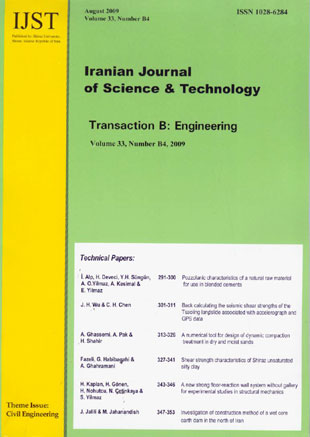فهرست مطالب

Iranian Journal of science and Technology (B: Engineering)
Volume:33 Issue: 4, August2009
- Civil Engineering
- 64 صفحه،
- تاریخ انتشار: 1388/06/25
- تعداد عناوین: 6
-
-
Pages 291-300In this study, the potential use of a natural raw material in the manufacture of blended cements was investigated. Mineralogical, petrographic and chemical analyses of the samples showed that the natural raw material was a porphyritic volcanic rock close to trachyandesite composition with a SiO2+Al2O3+Fe2O3 content of 79.86%. Further experiments were also designed to determine the physical properties and pozzolanic activity of the raw material. The mortar samples, made with a binder of ground trachyandesite and lime, developed compressive and flexural strengths of 2.5 and 3.3 times respectively higher than those required for a natural pozzolan. Further tests revealed that when the ground trachyandesite replaced 30% w/w of Portland cement, the blended cements produced had the desired physical and chemical characteristics with compressive strengths higher than 32.9 N/mm2. These findings suggest that this material can be used in the production of blended cements.
-
Pages 301-311In this study, the seismic displacement-based back-calculation is discussed and is conducted to analyze the shear strength parameters of the Tsaoling landslide under the impact of the Chi-Chi earthquake. Since the intensive earthquake tilted the ground shifted velocity when integrating seismic acceleration records, the co-seismic displacements measured by neighboring GPS stations played an essential role on baseline corrections of the acceleration time-history adjoining the Tsaoline landslide. In addition, an analysis process of combining empirical formula with Newmark’s sliding model simplifies the back-calculation procedure that only assuming the cohesion is required to calculate the internal friction angle of the sliding surface. Although the baseline correction changes the time-history of seismic accelerations, it has an insignificant impact on calculating the shear strength parameters of the Tsaoling landslide. The analysis results indicate that the cohesion is 0 kPa and the internal friction angle is 27.5° for the sliding surface.
-
Pages 313-326Dynamic compaction (DC) is a popular soil improvement method that is extensively used worldwide. DC treatment design is usually carried out based on past experiences and empirical relations. To establish a rational design approach, all important factors affecting the DC process should be taken into account. In this paper, a finite element code is developed for modeling the impact behavior of dry and moist granular soils. The code is verified with the results of some centrifuge tests. Several analyses were conducted in order to study the effects of energy/momentum per drop, tamper base radius, and number of drops on compaction degree, compacted depth, and extension of the improved zone in the ground. The developed code has considerable capabilities to be used as a tool for designing dynamic compaction treatments.
-
Pages 327-341This paper provides the results of ten triaxial tests which were carried out to study the unsaturated shear strength characteristics of Shiraz silty clay soil. The soil tested was reconstituted using static compaction. Consolidated drained (CD) triaxial tests were performed on both saturated and unsaturated samples at various net confining pressures and matric suctions. Digital image processing technique is used to measure the total volume change of the specimens. The accuracy of this technique is discussed by comparing the results with the volume change of the saturated tests determined from the conventional method. The volume change is also used to determine the change in sample diameter which is used to correct the deviatoric stress accordingly. Shear strength parameters and are determined from the test results and dependence of parameter χ on soil suction is studied and compared with the available relationships in literature. Furthermore, it is shown that the shear strength of both saturated and unsaturated soil specimens fall on a single line in the effective stress space. Therefore, applicability of the effective stress principle for the shear strength of unsaturated Shiraz silty clay is clearly validated.
-
Pages 343-346Strong floors and reaction walls are important elements of structural mechanics laboratories. They should be designed before the construction of the laboratory building for efficiency. They have a gallery used for the anchorage of the test models and storage of test equipment. In this paper, a strong floor without a gallery has been designed for an existing laboratory facility. The anchorage system has been designed to fix the model structures to the strong floor. Design issues of strong floor and reaction floor systems are mentioned in the scope of the paper. The construction of the system is simple and economical and provides a comfortable environment for experimental studies.
-
Pages 347-353In this research note, a procedure for finding the specifications for compaction of the core material of an earth dam in the humid climate of the north of Iran has been presented. Laboratory experiments on the soil itself together with studies on samples taken from a test-embankment constructed in the field indicates such a procedure can be followed in order to obtain the specifications for construction of wet cores of dams in other humid regions around the world as well.

